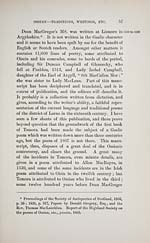Download files
Complete book:
Individual page:
Thumbnail gallery: Grid view | List view

58 OSSIAN — TRADITIONS, WRITINGS, ETC.
wrote ; and it seems highly improbable that a long and
well-known traditional poem should have escaped the
Dean's notice, while a short one on the same subject
was written down. Lome is close to Morven, but
there is no mention of Fingal or his kingdom. It is
thus proved that Fionn and his heroes are not simply
creatures of MacPherson's brain, or worthies who be-
long exclusively to Irish romance ; and it seems pro-
bable that some one has added a "gal" to Fionn, and
given him a kingdom, in the same way that the Gaelic
name Temair has been expanded to Temora and con-
tracted to Tara since 1391.
It is proved that " Earse " was a written language
three centuries ago, and has altered but little since,
and that Johnson and his followers erred in many
things. It is proved that old materials existed in
Scotland from which some one might have concocted
at least one book of Temora without stealing from
Ireland. And the out-and-out supporters of the
antiquity of the Gaelic of 1807 are bound to produce
something like Temora as it now stands in some manu-
script, equally old, though it has been ingeniously sug-
gested that the great traditional poems were then so
notorious and so well preserved that no one would
take the trouble to write them down or multiply
copies. The Gaelic, then, of the poems of Temora, as
published, was probably put together by some Gaelic
bard who lived between 1530 and 1763, when the
Gaelic of the 7th book of Temora was printed, though
Oisein lived and sung long before the twelfth century.
It remains to be seen whether the probable date of the
published poems of 1807 cannot be more accurately
determined.
Dean MacGregor's MS. was partly written in
wrote ; and it seems highly improbable that a long and
well-known traditional poem should have escaped the
Dean's notice, while a short one on the same subject
was written down. Lome is close to Morven, but
there is no mention of Fingal or his kingdom. It is
thus proved that Fionn and his heroes are not simply
creatures of MacPherson's brain, or worthies who be-
long exclusively to Irish romance ; and it seems pro-
bable that some one has added a "gal" to Fionn, and
given him a kingdom, in the same way that the Gaelic
name Temair has been expanded to Temora and con-
tracted to Tara since 1391.
It is proved that " Earse " was a written language
three centuries ago, and has altered but little since,
and that Johnson and his followers erred in many
things. It is proved that old materials existed in
Scotland from which some one might have concocted
at least one book of Temora without stealing from
Ireland. And the out-and-out supporters of the
antiquity of the Gaelic of 1807 are bound to produce
something like Temora as it now stands in some manu-
script, equally old, though it has been ingeniously sug-
gested that the great traditional poems were then so
notorious and so well preserved that no one would
take the trouble to write them down or multiply
copies. The Gaelic, then, of the poems of Temora, as
published, was probably put together by some Gaelic
bard who lived between 1530 and 1763, when the
Gaelic of the 7th book of Temora was printed, though
Oisein lived and sung long before the twelfth century.
It remains to be seen whether the probable date of the
published poems of 1807 cannot be more accurately
determined.
Dean MacGregor's MS. was partly written in
Set display mode to: Large image | Transcription
Images and transcriptions on this page, including medium image downloads, may be used under the Creative Commons Attribution 4.0 International Licence unless otherwise stated. ![]()
| Early Gaelic Book Collections > Matheson Collection > Popular tales of the west Highlands > Volume 4 > (74) |
|---|
| Permanent URL | https://digital.nls.uk/81487945 |
|---|
| Description | Volume IV. |
|---|---|
| Shelfmark | Mat.77 |
| Additional NLS resources: | |
| Attribution and copyright: |
|
| Description | Items from a collection of 170 volumes relating to Gaelic matters. Mainly philological works in the Celtic and some non-Celtic languages. Some books extensively annotated by Angus Matheson, the first Professor of Celtic at Glasgow University. |
|---|
| Description | Selected items from five 'Special and Named Printed Collections'. Includes books in Gaelic and other Celtic languages, works about the Gaels, their languages, literature, culture and history. |
|---|

